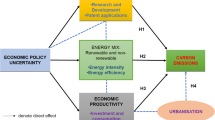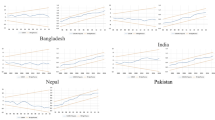Abstract
Economic growth and economic energy consumption have received greater attention due to its contribution to global CO2 emissions in recent decades. The literature on CO2 emissions and innovation for regional differences is very scanty as there is not enough study that considered different regions in a single analysis. We adopt a holistic approach by incorporating different regions so as to assess how innovation contributes to emission reduction. The study, therefore, examined the effects of innovation and economic growth on CO2 emissions for 18 developed and developing countries over the period of 1990 to 2016. The study used panel technique capable of dealing with cross-section dependence effects: panel cross-sectional augmented Dickey-Fuller (CADF) unit root to determine the order of integration, Westerlund cointegration tests confirmed that the variables are co-integrated. We employed panel fully modified ordinary least square (FMOLS) and panel dynamic ordinary least square (DOLS) to estimate the long-run relationship. The results show that energy consumption increases CO2 emissions at all panel levels. However, innovation reduces CO2 emissions in G6 while it increases emissions in the MENA and the BRICS countries. Environmental Kuznets curve (EKC) hypothesis is valid for the BRICS. The pollution haven hypothesis (PHH) and pollution halo effect were confirmed at different panel levels. Based on the findings different policy recommendations are proposed.
Similar content being viewed by others
References
Abdouli M, Hammami S (2017) Economic growth, FDI inflows and their impact on the environment: an empirical study for the MENA countries. Qual Quant 51:121–146
Acheampong AO (2018) Economic growth, CO2 emissions and energy consumption: what causes what and where? Energy Econ 74:677–692
Albino V, Ardito L, Dangelico RM, Petruzzelli AM (2014) Understanding the development trends of low-carbon energy technologies: A patent analysis. Appl Energy 135:836–854
Al-Mulali U, Sheau-Ting L, Ozturk I (2015) The global move toward Internet shopping and its influence on pollution: an empirical analysis. Environ Sci Pollut Res 22:9717–9727
Andreoni J, Levinson A (2001) The simple analytics of the environmental Kuznets curve. J Publ Econ 80:269–286
Antweiler W, Copeland BR, Taylor MS (2001) Is free trade good for the environment? Am Econ Rev 91:877–908
Apergis N, Eleftheriou S, Payne JE (2013) The relationship between international financial reporting standards, carbon emissions, and R&D expenditures: evidence from European manufacturing firms. Ecol Econ 88:57–66
Aronsson T, Backlund K, Sahlén L (2010) Technology transfers and the clean development mechanism in a north–south general equilibrium model. Resour Energy Econ 32:292–309
Arrow K, Bolin B, Costanza R, Dasgupta P, Folke C, Holling CS, Jansson BO, Levin S, Mäler KG, Perrings C, Pimentel D (1995) Economic growth, carrying capacity, and the environment. Ecol Econ 15:91–95
Balsalobre D, Álvarez A, Cantos JM (2015) Public budgets for energy RD&D and the effects on energy intensity and pollution levels. Environ Sci Pollut Res 22:4881–4892
Balsalobre-Lorente D, Shahbaz M, Roubaud D, Farhani S (2018a) How economic growth, renewable electricity and natural resources contribute to CO2 emissions? Energy Policy 113:356–367
Balsalobre-Lorente D, Shahbaz M, Tiwari AK, Jabbour JC (2018b) The applicability of the inflection point in the environmental correction process
Bekhet HA, Othman NS (2017) Impact of urbanization growth on Malaysia CO2 emissions: evidence from the dynamic relationship. J Clean Prod 154:374–388
Chen J, Wang P, Cui L, Huang S, Song M (2018) Decomposition and decoupling analysis of CO2 emissions in OECD. Appl energy 231:937–950
Copeland BR, Taylor MS (2004) Trade, growth, and the environment. J Econ Lit 42:7–71
Dogan E, Seker F (2016) Determinants of CO2 emissions in the European Union: the role of renewable and non-renewable energy. Renew Energy 94:429–439
Dong K, Sun R, Hochman G (2017) Do natural gas and renewable energy consumption lead to less CO2 emission? Empirical evidence from a panel of BRICS countries. Energy 141:1466–1478
Ertugrul HM, Cetin M, Seker F, Dogan E (2016) The impact of trade openness on global carbon dioxide emissions: evidence from the top ten emitters among developing countries. Ecol Indic 67:543–555
Fernández YF, López MF, Blanco BO (2018) Innovation for sustainability: the impact of R&D spending on CO2 emissions. J Clean Prod 172:3459–3467
Flikkema M, Castaldi C, De Man A-P, Seip M (2015) Explaining the trademark-innovation linkage: the role of patents and trademark filing strategies. Acad Manag Proceed 2015:1
Foxon TJ (2011) A coevolutionary framework for analysing a transition to a sustainable low carbon economy. Ecol Econ 70:2258–2267
Gotsch M, Hipp C (2014) Using trademarks to measure innovation in knowledge-intensive business services. Technol Innov Manag Rev 4
Grossman G-H, Helpman E (1991) Innovation and growth in the global economy. MTTPress, Cambridge
Grossman GM, Krueger AB (1991) Environmental impacts of a north American free trade agreement. Natl Bur Econ Res
Grossman GM, Krueger AB (1995) Economic growth and the environment. Q J Econ 110:353–377
Hanna R (2010) US environmental regulation and FDI: evidence from a panel of US-based multinational firms. Am Econ J: Appl Econ 2:158–189
Hicks J (1963) The theory of wages. Springer
Hossain MS (2011) Panel estimation for CO2 emissions, energy consumption, economic growth, trade openness and urbanization of newly industrialized countries. Energy Policy 39:6991–6999
Hübler M, Baumstark L, Leimbach M, Edenhofer O, Bauer N (2012) An integrated assessment model with endogenous growth. Ecol Econ 83:118–131
IEA (2014) Energy, climate change and environment 2014 insights. Int Energy Agency
IEA (2016) Energy, climate change and environment 2016 insights vol 2019. Int Energy Agency
Irandoust M (2016) The renewable energy-growth nexus with carbon emissions and technological innovation: evidence from the Nordic countries. Ecol Indic 69:118–125
Jaffe AB, Stavins RN (1994) The energy-efficiency gap what does it mean? Energy Policy 22:804–810
Johansen S (1988) Statistical analysis of cointegration vectors. J Econ Dyn Control 12:231–254
Kahouli B (2018) The causality link between energy electricity consumption, CO2 emissions, R&D stocks and economic growth in Mediterranean countries (MCs). Energy 145:388–399
Kao C (1999) Spurious regression and residual-based tests for cointegration in panel data. J Econ 90:1–44
Le T-H, Chang Y, Park D (2016) Trade openness and environmental quality. Int Evid Energy Policy 92:45–55
Liobikienė G, Butkus M (2018) The challenges and opportunities of climate change policy under different stages of economic development. Sci Total Environ 642:999–1007
Liobikienė G, Butkus M (2019) Scale, composition, and technique effects through which the economic growth, foreign direct investment, urbanization, and trade affect greenhouse gas emissions. Renew Energy 132:1310–1322
Long X, Luo Y, Wu C, Zhang J (2018) The influencing factors of CO2 emission intensity of Chinese agriculture from 1997 to 2014. Environ Sci Pollut Res 25:13093–13101
Managi S, Hibiki A, Tsurumi T (2009) Does trade openness improve environmental quality? J Environ Econ Manag 58:346–363
Meadows DH, Meadows DH, Randers J, Behrens III WW (1972) The limits to growth: a report to the club of Rome (1972) Google scholar
Mensah CN, Long X, Boamah KB, Bediako IA, Dauda L, Salman M (2018) The effect of innovation on CO2 emissions of OCED countries from 1990 to 2014. Environ Sci Pollut Res 25:29678–29698
Metz B, Davidson OR, Bosch PR, Dave R, Meyer LA (2007) Contribution of working group III to the fourth assessment report of the intergovernmental panel on climate change, 2007. Cambridge University Press, Cambridge
Mihci H, Cagatay S, Koska O (2005) The impact of environmental stringency on the foreign direct investments of the OECD countries. J Environ Assess Policy Manag 7:679–704
Nordhaus WD (2007) A review of the stern review on the economics of climate change. J Econ Lit 45:686–702
Omri A, Daly S, Rault C, Chaibi A (2015) Financial development, environmental quality, trade and economic growth: what causes what in MENA countries. Energy Econ 48:242–252
Ozturk I, Acaravci A (2013) The long-run and causal analysis of energy, growth, openness and financial development on carbon emissions in Turkey. Energy Econ 36:262–267
Pesaran MH (2004) General diagnostic tests for cross section dependence in panels
Pesaran MH (2007) A simple panel unit root test in the presence of cross-section dependence. J Appl Econ 22:265–312
Potepa J, Welch KT (2018) Calibrating innovation proxies with an accurate Tobin’s Q and appraised innovation value
Rafindadi AA, Muye IM, Kaita RA (2018) The effects of FDI and energy consumption on environmental pollution in predominantly resource-based economies of the GCC. Sustain Energy Technol Assess 25:126–137
Raiser K, Naims H, Bruhn T (2017) Corporatization of the climate? Innovation, intellectual property rights, and patents for climate change mitigation. Energy Res Soc Sci 27:1–8
Romer PM (1990) Endogenous technological change. J Polit Econ 98:S71–S102
Salahuddin M, Ali MI, Vink N, Gow J (2018) The effects of urbanization and globalization on CO2 emissions: evidence from the Sub-Saharan Africa (SSA) countries. Environ Sci Pollut Res 1–11
Samargandi N (2017) Sector value addition, technology and CO2 emissions in Saudi Arabia. Renew Sust Energ Rev 78:868–877
Sannassee RV, Seetanah B (2016) Trade openness and CO2 emission: evidence from a SIDS. In: Handbook of Environmental and Sustainable Finance. Elsevier, pp 165–177
Saud S, Chen S, Haseeb A (2018) Impact of financial development and economic growth on environmental quality: an empirical analysis from Belt and Road Initiative (BRI) countries. Environ Sci Pollut Res 1–17
Schultz TW (1975) The value of the ability to deal with disequilibria. J Econ Lit 13:827–846
Schumpeter JA (1934) Change and the entrepreneur essays of JA Schumpeter
Shahbaz M, Balsalobre D, Shahzad SJH (2018) The influencing factors of CO2 emissions and the role of biomass energy consumption: statistical experience from G-7 countries. Environ Model Assess 1–19
Stokey NL (1998) Are there limits to growth? Int Econ Rev 1–31
Sun C, Zhang F, Xu M (2017) Investigation of pollution haven hypothesis for China: an ARDL approach with breakpoint unit root tests. J Clean Prod 161:153–164
Talbi B (2017) CO2 emissions reduction in road transport sector in Tunisia. Renew Sust Energ Rev 69:232–238
Wang C (2013) The long-run effect of innovation on economic growth School of Economics. Sydney, UNSW
Wang S, Fang C, Guan X, Pang B, Ma H (2014) Urbanisation, energy consumption, and carbon dioxide emissions in China: a panel data analysis of China’s provinces. Appl Energy 136:738–749
Wang Q, Zeng Y-E, Wu B-W (2016) Exploring the relationship between urbanization, energy consumption, and CO2 emissions in different provinces of China. Renew Sust Energ Rev 54:1563–1579
Wang B, Sun Y, Wang Z (2018) Agglomeration effect of CO2 emissions and emissions reduction effect of technology: a spatial econometric perspective based on China’s province-level data. J Clean Prod 204:96–106
Westerlund J (2007) Testing for error correction in panel data. Oxf Bull Econ Stat 69:709–748
Yii K-J, Geetha C (2017) The Nexus between technology innovation and CO2 emissions in Malaysia: evidence from Granger causality test. Energy Proced 105:3118–3124
Young A (1991) Learning by doing and the dynamic effects of international trade the quarterly. J Econ 106:369–405
Yu Y, Du Y (2018) Impact of technological innovation on CO2 emissions and emissions trend prediction on “new normal” economy in China. Atmos Pollut Res
Zhu H, Duan L, Guo Y, Yu K (2016) The effects of FDI, economic growth and energy consumption on carbon emissions in ASEAN-5: evidence from panel quantile regression. Econ Model 58:237–248
Zhu H, Xia H, Guo Y, Peng C (2018) The heterogeneous effects of urbanization and income inequality on CO2 emissions in BRICS economies: evidence from panel quantile regression. Environ Sci Pollut Res 1–18
Funding
We appreciate the financial support provided by National Natural Science Foundation of China (No. 71603105); Natural Science Foundation of Jiangsu, China (No. SBK2016042936); Science Foundation of Ministry of Education of China (No. 16YJC790067); and China Postdoctoral Science Foundation (Nos. 2017M610051, 2018T110054).
Author information
Authors and Affiliations
Corresponding author
Additional information
Responsible editor: Philippe Garrigues
Publisher’s note
Springer Nature remains neutral with regard to jurisdictional claims in published maps and institutional affiliations.
Rights and permissions
About this article
Cite this article
Dauda, L., Long, X., Mensah, C.N. et al. The effects of economic growth and innovation on CO2 emissions in different regions. Environ Sci Pollut Res 26, 15028–15038 (2019). https://doi.org/10.1007/s11356-019-04891-y
Received:
Accepted:
Published:
Issue Date:
DOI: https://doi.org/10.1007/s11356-019-04891-y




